|
|
The
History
Of
Bulgaria
First
Bulgarian Empire |
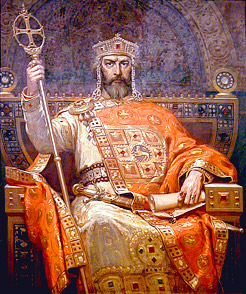 |
|
During the time of the late Roman
Empire, the lands of present-day Bulgaria had been organised in
several provinces - Scythia (Scythia Minor), Moesia (Upper and
Lower), Thrace, Macedonia (First and Second), Dacia (Coastal and
Inner, both situated south of Danube), Dardania, Rhodope and
Hemimont, and had a mixed population of Romanised Thracians
(Vlachs) and Greeks. Several consecutive waves of Slavic
migration throughout the 6th and the early 7th century led to a
dramatic change of the demographics of the region and its almost
complete "Slavonisation".
The Bulgars
Little is known about the orgins of the Bulgars that reached the
Balkan peninsula in the 7th century AC (according to some
sources even earlier) because during the ages the original
Bulgars melted into the local population of what is nowadays
Bulgaria.
One theory is that the Bulgars originated in central Asia but
their origin is not entirely clear. The established theory is
that the Bulgars are related to the Huns. Clues for this can be
found in the advanced calendar and system of government of the
early Bulgars.
However more recent studies in genetics have tried to show that
the Bulgars were not directly linked to the Huns and the Bulgars
originated from what is nowadays Eastern Ukraine. It is possible
that Bulgarian rulers employed Huns and had close cultural
relations with them but were very ethically different.
The Bulgars were governed by hereditary khans. There were
several aristocratic families whose members, bearing military
titles, formed a governing class. Bulgars were monotheistic,
worshipping the Sun god (Tangra).
The migration of Bulgars to the European continent started as
early as the 2nd century AD when branches of Bulgars settled on
the plains between the Caspian and the Black Sea. Between 351
and 389 AD, some of these crossed the Caucasus and settled in
Armenia. They were eventually assimilated by the Armenians.
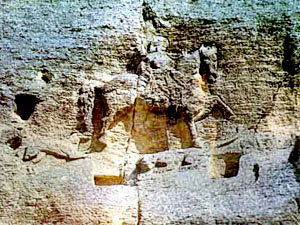
Bulgar art: The
Madara Rider (ca. 710 AD), large rock relief
carved on the Madara Plateau east
of Shumen, northeast Bulgaria.
Swept by the Hunnish wave at the beginning of the 4th century
AD, other numerous Bulgarian tribes broke loose from their
settlements in central Asia to migrate to the fertile lands
along the lower valleys of the Donets and the Don rivers and the
Azov seashore. Some of these remained for centuries in their new
settlements, whereas others moved on with the Huns towards
Central Europe, settling in Pannonia.
In the 6th and 7th century, the Bulgars formed an independent
state, often called Great Bulgaria, between the lower course of
the Danube to the west, the Black and the Azov Seas to the
south, the Kuban river to the east, and the Donets river to the
north. The capital of the state was Phanagoria, on the Azov.

The Sword
of Khan Kubrat - the founder of
Great Bulgaria,
found at Malaya Pereshchepina,
Ukraine
The pressure from peoples further east (such as the Khazars) led
to the dissolution of Great Bulgaria in the second half of the
7th century. One Bulgar tribe migrated to the confluence of the
Volga and Kama Rivers in what is now the Russian Federation (see
Volga Bulgaria). They converted to Islam in the beginning in the
8th century and maintained an independent state until the 13th
century. Smaller Bulgar tribes seceded in Pannonia and in Italy,
northwest of Naples, while other Bulgars sought refuge with the
Lombards. Another group of Bulgars remained in the land north of
the Black and the Azov Seas. They were, however, soon subdued by
the Khazars. These Bulgars converted to Judaism in the 9th
century, along with the Khazars, and were eventually
assimilated.
Establishment and development of the Bulgarian state
|
Yet
another Bulgar tribe, led by Khan Asparuh, moved westward,
occupying todayís southern Bessarabia. After a successful
war with Byzantium in 680 AD, Asparuhís khanate conquered
Moesia and Dobrudja and was recognised as an independent
state under the subsequent treaty signed with the
Byzantine Empire in 681 AD. The same year is usually
regarded as the year of the establishment of present-day
Bulgaria.
Another opinion is that Great Bulgaria, although it
suffered a major territory loss from the
|
 |
|
Khan Asparuh |
|
Khazars, managed to defeat them in the early 70s of the 7th
century. Khan Asparuh, the successor of Khan Kubrat, conquered
Moesia and Dobrudja after a war with Byzantine
Empire in 680 AD. This war ended with signing a peace treaty in
681. Therefore the year of establishment of present-day Bulgaria
has to be considered 632, and not 681 AD.
Territorial expansion
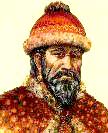 |
|
Khan Krum
(803 - 814) |
|
Under
the warrior Khan Krum (802-814), also known as Crummus and
Keanus Magnus, Bulgaria expanded northwest and southwards,
occupying the lands between middle Danube and Moldova, the
whole territory of present-day Romania, Sofia in 809 and
Adrianople (modern Edirne) in 813, and threatening
Constantinople itself. According to some late sources Khan
Krum implemented law reform intending to reduce the
poverty and to strengthen the social
|
ties
in his vastly enlarged state. During
the reign of Khan Omurtag (814-831), the northwestern boundaries
with the Frankish Empire were firmly settled
along the
|
middle Danube and
magnificent palace, pagan temples, rulerís residence, fortress,
citadel, water-main and bath were built in Bulgarian capital
Pliska, mainly of stone and brick. Under Boris I the Bulgarians
became Christians, and the Ecumenical Patriarch agreed to allow
an autonomous Bulgarian Archbishop at Pliska.
The Bulgars were greatly outnumbered by the Slav and native
Vlach populations among whom they had settled. Between the 7th
and the 10th centuries, the Bulgars were gradually absorbed by
the Slavs, adopting a South Slav language and converting to
Christianity (of the Byzantine rite) under Boris I in 864. At
that time the process of absorption of the elements of the old
Vlach (Romanised Thracians) population from south of the Danube,
had already been significant in the formation of this new
ethnos. However, unlike the Turanian Bulgars, the Vlachs would
exist as separate from the slavophone Bulgarians well into the
Middle Ages. Pockets of native Vlach populations still exist in
todays Bulgaria.
The Bulgarians were classified as a Southern Slavic people
related to the Serbs, rather than as a Turanian one. With
the adoption of christianity the title khan changed to
kniaz (Slavonic for prince). Later on, Simeon I (the son
of Boris)
adopted the title Tsar of Bulgaria, and ruler of the
Bulgarian
|
 |
|
"A good life
though he may have led, a man shall die and another
shall be born. May the later-born who see this
remember its creator".
Khan Omurtag-831 |
|
Empire (called by some historians the West Bulgarian Empire to
distinguish it from the lands of the Turanian Bulgars who still
lived in the Volga valley).
Cultural development
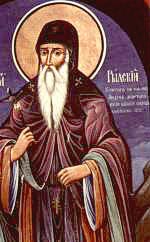 |
|
St. Ivan Rilski
(St. John of Rila)
876-946 |
|
Missionaries
from Constantinople, Cyril and Methodius, devised the
Glagolitic alphabet, which was adopted in the Bulgarian
Empire around 886. The alphabet and the Old Bulgarian
language gave rise to a rich literary and cultural
activity centered around the Preslav and Ohrid Literary
Schools, established by order of Boris I in 886. In the
beginning of 10th century AD, a new alphabet - the
Cyrillic alphabet - was developed on the basis of Greek
and Glagolitic cursive at the Preslav Literary School.
According to an alternative theory, the alphabet was
devised at the Ohrid Literary School |
by Saint Climent of Ohrid, a Bulgarian scholar and
disciple of Cyril and Methodius.
A pious monk and hermit St Ivan of Rila (Ivan Rilski, 876-946),
became the patron saint of Bulgaria. After 893 Preslav became
truly new and in many aspects authentic Bulgarian capital.
The "Golden Age"
|
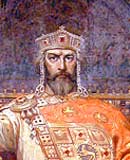 |
|
Simeon the Great,
Tsar (Caesar) of the
Bulgarians
and the Greeks |
By the late 9th and the beginning of the 10th century, Bulgaria
extended to Epirus and Thessaly in the south, Bosnia in the west
and controlled the whole of present-day Romania and eastern
Hungary to the north. A Serbian state came into existence as a
dependency of the Bulgarian Empire. Under Tsar Simeon I (Simeon
the Great), who was educated in Constantinople, Bulgaria became
again a serious threat to the Byzantine Empire. Simeon hoped to
take Constantinople and make himself Emperor of both Bulgarians
and Greeks, and fought a series of wars with the Byzantines
through his long reign (893-927). The war boundary towards the
end of his rule reached Peloponnese in the south. Simeon
proclaimed himself "Tsar (Caesar) of the Bulgarians and the
Greeks," a title which was recognised by the Pope, but not of
course by the Byzantine Emperor.
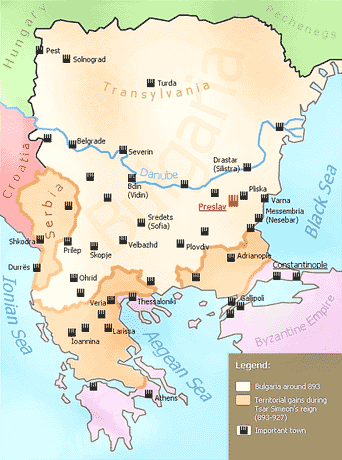
The First Bulgarian Empire's
greatest territorial extent during
the reign of Tsar Simeon
Decline
After Simeon's death, however, Bulgarian power declined. Under
Peter I and Boris II the country was divided by the egalitarian
religious heresy of the Bogomils, and distracted by wars with
the Hungarians to the north and the breakaway state of Serbia to
the west. In 972 Emperor John Tsimisces was able to make eastern
Bulgaria a Byzantine protectorate. The Bulgarians maintained an
independent state for a time in the western part of the country,
but in 1014 Emperor Basil II defeated the armies of Tsar Samuil
at the Balasita and massacred thousands, acquiring the title
"Bulgar-slayer" (Voulgaroktonos). He ordered 14,000 Bulgarian
prisoners blinded and sent back to their country. At the sight
of his returning armies Samuil suffered a heart attack and died.
By 1018 the country had been mostly subjugated by the
Byzantines.
 |









